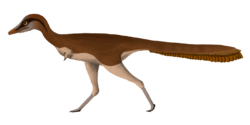Biology:Ondogurvel
| Ondogurvel | |
|---|---|

| |
| Life reconstruction of O. alifanovi | |
| Scientific classification | |
| Domain: | Eukaryota |
| Kingdom: | Animalia |
| Phylum: | Chordata |
| Clade: | Dinosauria |
| Clade: | Saurischia |
| Clade: | Theropoda |
| Family: | †Alvarezsauridae |
| Subfamily: | †Parvicursorinae |
| Genus: | †Ondogurvel Averianov & Lopatin, 2022 |
| Species: | †O. alifanovi
|
| Binomial name | |
| †Ondogurvel alifanovi Averianov & Lopatin, 2022
| |
Ondogurvel (IPA: [ɒndɒɡurw̜iɮ]) (meaning "egg lizard") is a genus of alvarezsaurid dinosaur from the Late Cretaceous (Campanian) Barun Goyot Formation in southern Mongolia. The type and only species is O. alifanovi, known from a partial skeleton consisting of fragments of two last dorsal vertebrae, three anterior sacral vertebrae, right ilium, left and right pubis and ischium, articulated right tibia, fibula, metatarsals II and IV, and phalanges IV-1 and IV-2, right carpometacarpus, left and right manual phalanx II-1, right femur, left pedal phalanx II-1, and fragments of unidentified phalanges.[1]
Discovery and naming
In 2022, the type species Ondogurvel alifanovi was named and described by Alexander O. Averianov and Alexey V. Lopatin. The generic name, "Ondogurvel" combines the Mongolian words өндөг “ondo” (IPA: [ɒndɒ]), meaning egg, and гүрвэл “gurvel” (IPA: [ɡurw̜iɮ]), meaning lizard. The specific name, "alifanovi" (IPA: [ɑːlɪfɑːnɔːvaɪ]) honors the late Russian paleontologist Vladimir Alifanov who found the holotype specimen (PIN 5838/1) in 1999.[1]
Description
Ondogurvel was a bipedal theropod. Like other parvicursorines, it had a robust humerus, and long hindlimbs suggesting a cusorial lifestyle. It is unique in that, unlike all other alvarezsaurids, it has metartarsals II and IV completely fused along their contact area.[1]
The following differences from the Parvicursor, another parvicursorine from the Barun Goyot Formation, were identified by Averianov & Lopatin (2022):[1]
- dorsally arcuate supraacetabular crest of the ilium;
- the tibia less curved labially in transverse plane;
- relatively shorter pedal phalanx II-1.
On the other hand, describers noted that the femora of Ondogurvel and Parvicursor are almost identical.[1] Mickey Mortimer has suggested that Ondogurvel may be a junior synonym of Parvicursor, which is known only from a juvenile individual.[2]
Classification
Averianov and Lopatin (2022) place Ondogurvel in the alvarezsaurid subfamily Parvicursorinae which are classified by their manus morphology. They recovered that Ondogurvel formed a clade with Xixianykus and Albinykus which have proximally co-ossified metatarsals II and IV. The describing paper also proposes that the "drastic difference in the morphology of the carpometacarpus [across Parvicursorinae] may suggest a deep divergence between the parvicursorine lineages represented by [Dzharaonyx] – Linhenykus and Mononykus – Ondogurvel".
Phylogeny after Averianov & Lopatin (2022):[1]
| Alvarezsauridae |
| ||||||||||||||||||||||||||||||||||||||||||||||||||||||||||||||||||||||||
Paleoecology
Nemegtomaia, an oviraptorosaur, is also known from the Nemegt locality of the Mongolian Barun Goyot Formation.[3] Other localities from the formation have yielded dinosaurs including other alvarezsaurids (Ceratonykus,[4] Khulsanurus,[5] and Parvicursor[6]), as well as dromaeosaurs (Hulsanpes,[7] Kuru,[8] and Shri[9]), oviraptorosaurs (Conchoraptor and Heyuannia),[10] a sauropod (Quaesitosaurus),[11] ceratopsians (Bagaceratops and Breviceratops),[12] a pachycephalosaur (Tylocephale),[13] and ankylosaurs (Saichania,[14] Tarchia,[15] and Zaraapelta[16]).
References
- ↑ 1.0 1.1 1.2 1.3 1.4 1.5 Alexander O. Averianov; Alexey V. Lopatin (2022-02-19). "A new alvarezsaurid theropod dinosaur from the Upper Cretaceous of Gobi Desert, Mongolia". Cretaceous Research 135: 105168. doi:10.1016/j.cretres.2022.105168. https://www.sciencedirect.com/science/article/abs/pii/S0195667122000325.
- ↑ Mortimer, Mickey. "Parvicursor Karhu and Rutian, 1996a". https://theropoddatabase.com/Ornithomimosauria.htm#Parvicursorremotus.
- ↑ Fanti, F.; Currie, P. J.; Badamgarav, D.; Lalueza-Fox, C. (2012). "New specimens of Nemegtomaia from the Baruungoyot and Nemegt Formations (Late Cretaceous) of Mongolia". PLOS ONE 7 (2): e31330. doi:10.1371/journal.pone.0031330. PMID 22347465. Bibcode: 2012PLoSO...731330F.
- ↑ Alifanov, V. R.; Barsbold, R. (2009-01-01). "Ceratonykus oculatus gen. et sp. nov., a new dinosaur (?Theropoda, Alvarezsauria) from the Late Cretaceous of Mongolia" (in en). Paleontological Journal 43 (1): 94–106. doi:10.1134/S0031030109010109. ISSN 1555-6174. https://www.researchgate.net/publication/226583988.
- ↑ Averianov, Alexander O.; Lopatin, Alexey V. (2021-11-18). "The second taxon of alvarezsaurid theropod dinosaurs from the Late Cretaceous Khulsan locality in Gobi Desert, Mongolia". Historical Biology 34 (11): 2125–2136. doi:10.1080/08912963.2021.2000976. ISSN 0891-2963. https://www.tandfonline.com/doi/abs/10.1080/08912963.2021.2000976?journalCode=ghbi20.
- ↑ Karhu, A. A.; Rautian, A. S. (1996). A new family of Maniraptora (Dinosauria: Saurischia) from the Late Cretaceous of Mongolia. Paleontological Journal. 30, 583−592.
- ↑ Osmólska, H. (1982). "Hulsanpes perlei n.g. n.sp. (Deinonychosauria, Saurischia, Dinosauria) from the Upper Cretaceous Barun Goyot Formation of Mongolia". Neues Jahrbuch für Geologie und Paläontologie, Monatshefte 1982 (7): 440–448. doi:10.1127/njgpm/1982/1982/440. https://www.schweizerbart.de/papers/njgpm/detail/1982/96212/Hulsanpes_perlei_n_g_n_sp_Deinonychosauria_Saurisc?af=crossref.
- ↑ Napoli, J. G.; Ruebenstahl, A. A.; Bhullar, B.-A. S.; Turner, A. H.; Norell, M. A. (2021). "A New Dromaeosaurid (Dinosauria: Coelurosauria) from Khulsan, Central Mongolia". American Museum Novitates (3982): 1–47. doi:10.1206/3982.1. ISSN 0003-0082. https://digitallibrary.amnh.org/bitstream/handle/2246/7286/3982.pdf?sequence=1&isAllowed=y.
- ↑ Turner, A. H.; Montanari, S.; Norell, M. A. (2021). "A New Dromaeosaurid from the Late Cretaceous Khulsan Locality of Mongolia". American Museum Novitates (3965): 1−48. doi:10.1206/3965.1. ISSN 0003-0082. http://digitallibrary.amnh.org/bitstream/handle/2246/7251/N3965.pdf?sequence=1&isAllowed=y.
- ↑ Funston, G. F.; Mendonca, S. E.; Currie, P. J.; Barsbold, R. (2018-04-01). "Oviraptorosaur anatomy, diversity and ecology in the Nemegt Basin" (in en). Palaeogeography, Palaeoclimatology, Palaeoecology. THE LATE CRETACEOUS NEMEGT ECOSYSTEM: DIVERSITY, ECOLOGY, AND GEOLOGICAL SIGNATURE 494: 101–120. doi:10.1016/j.palaeo.2017.10.023. ISSN 0031-0182. Bibcode: 2018PPP...494..101F. https://www.sciencedirect.com/science/article/pii/S0031018217306065.
- ↑ Kurzanov, S. M.; Bannikov, A. F. (1983). "A new sauropod from the Upper Cretaceous of Mongolia". Paleontological Journal 2: 90−96. https://moam.info/a-new-sauropod-from-the-upper-cretaceous-of-mongolia_5b764105097c4785168b45fe.html.
- ↑ Czepiński, Łukasz (2020-11-25). "Ontogeny and variation of a protoceratopsid dinosaur Bagaceratops rozhdestvenskyi from the Late Cretaceous of the Gobi Desert". Historical Biology 32 (10): 1394–1421. doi:10.1080/08912963.2019.1593404. ISSN 0891-2963. https://doi.org/10.1080/08912963.2019.1593404.
- ↑ Maryańska, T.; Osmólska, H. (1974). "Pachycephalosauria, a new suborder of ornithischian dinosaurs". Palaeontologica Polonica (30): 45−102. http://www.palaeontologia.pan.pl/Archive/1974_30_45-102_22-31.pdf.
- ↑ Carpenter, K., Hayashi, S., Kobayashi, Y., Maryańska, T., Barsbold, R., Sato, K., and Obata, I., 2011,"Saichania chulsanensis (Ornithischia, Ankylosauridae) from the Upper Cretaceous of Mongolia", Palaeontographica, Abteilung A, 294(1-3): 1-61
- ↑ Maryańska, T. 1977. "Ankylosauridae (Dinosauria) from Mongolia". Palaeontologia Polonica 37: 85-151
- ↑ Arbour, Victoria M.; Currie, Philip J.; Badamgarav, Demchig (2014-10-27). "The ankylosaurid dinosaurs of the Upper Cretaceous Baruungoyot and Nemegt formations of Mongolia". Zoological Journal of the Linnean Society 172 (3): 631–652. doi:10.1111/zoj.12185. ISSN 0024-4082. https://doi.org/10.1111/zoj.12185.
Wikidata ☰ Q110964964 entry
 |

